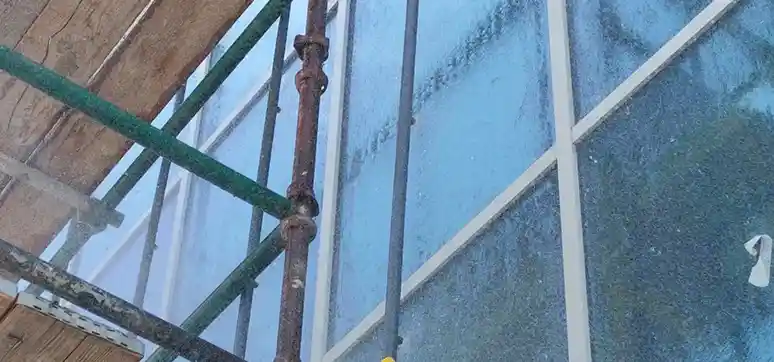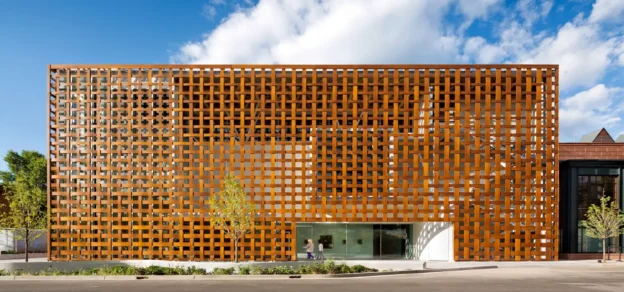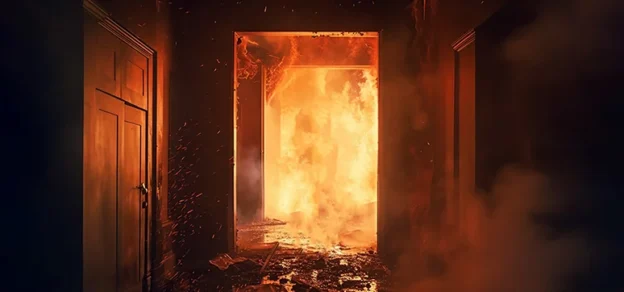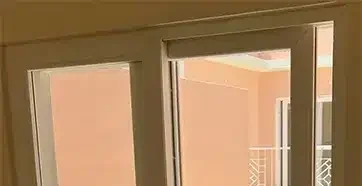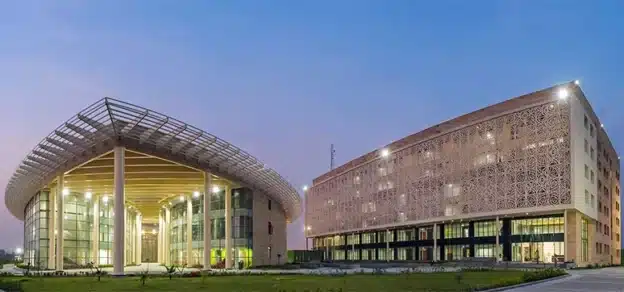The façade is a non-structural, exterior cladding system that is typically made of lightweight materials such as glass, aluminium, or composite panels. It is used to enclose a building’s exterior, providing a protective barrier against the elements while allowing natural light to enter the building.
These are typically designed as a series of individual panels that are connected to the building’s structural frame. The panels are supported by brackets or anchors that are attached to the building’s structural elements, such as concrete slabs or steel beams. The façade of a building is often the most important aspect from a design standpoint, as it sets the tone for the building. From an engineering perspective, it is crucial due to its impact on energy efficiency. Given the criticality, it is strongly advised that a prototype of this foundation is tested at the initial stage to validate the design.
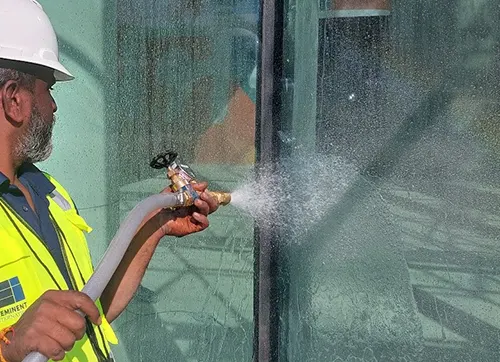
The ideal time to perform the testing on the prototype would be once the design is finalised and the materials are selected and approved. Performance prototype testing can help identify any issues with the façade system before it is installed in the building. This allows for necessary modifications or improvements to be made early in the process, reducing the risk of costly remedial work later on.
It can help verify the effectiveness of the design and installation of the façade system, ensuring that it meets the intended performance requirements and is installed correctly. The Prototype testing is in line with the building codes, construction standards, and industry guidelines to ensure the safety and performance of building façades. Compliance with these requirements can help prevent costly remedial work and potential legal issues. Upon testing and validation of the design, there is a 90% guarantee that the façade will withstand calamities with regard to air, water, wind and building movements, etc.
A dynamic water penetration test is one of the important tests that should be performed as part of prototype testing. And this can be conducted only in the laboratory. The testing consists of a portable wind generator and installing a spray rack system at the exterior of the specimen. It combines volumes of water with high buffeting winds delivered by an aeroplane engine or another similar wind generator.
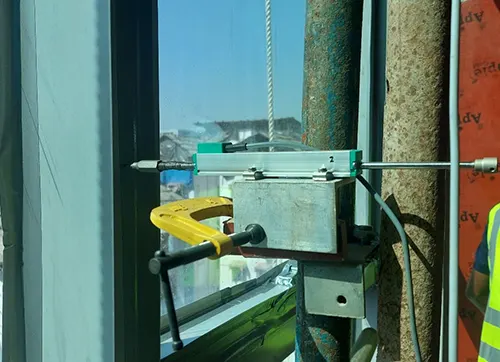
• The wind produced shall be adjusted to equivalent static pressure. Water is sprayed with an array of nozzles and simultaneously the required wind speed is produced by a wind generator. During the test, the façade is observed for any signs of water penetration or leakage. The water that penetrates the façade is collected on the inside of the façade system to measure the amount of water that enters the building envelope. This test is typically performed for a specified duration [approx. 15 minutes] and is intended to test if the façade can withstand the effects of a heavy rainstorm.
• Next is the Thermal Cycling Test (Weathering Test) which is performed to determine the resistance of exposure to alternating extremes of high and low temperatures. This again can be conducted only in the laboratory.
The target parameters for the high and low-temperature phases are the air temperatures defined as per the standard [Per standard AAMA 501.5 – High temperature is up to 82o C and low temperature is -18o C]. The number and duration of the cycles can vary depending on the specific requirements of the test and the expected conditions that the façade system will be subjected to in its actual use.
The façade sample is monitored for any signs of damage or deterioration, such as cracking, delamination, or loss of adhesion etc. In addition to the pressure-tight test chamber, a sealed test chamber plus air-conditioning equipment is required to regulate the temperatures in order to carry out the thermal cycling sequence.
Constant temperature conditions are maintained inside the corresponding interior of the prototype, while the exterior of the prototype is subject to changing temperatures according to the defined test cycle.
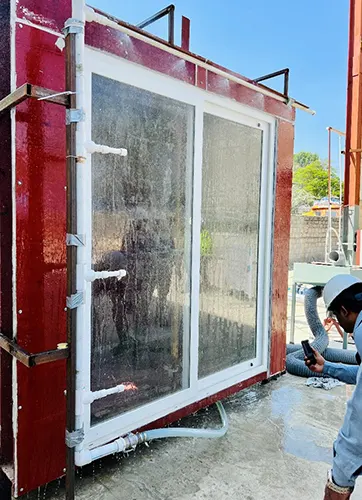
• Another important test would be the ‘Building Movement Test’. This test provides a performance evaluation of the façade when subjected to the specified displacements (horizontal/ vertical); for example, an earthquake. Furthermore, it is intended to analyse the seismic safety of architectural glass components within a façade. Testing is done at three cycles where a single cycle is defined as a full displacement in both directions and back. Each cycle is completed in about 2 minutes. After the tests, all the areas are inspected in detail and observed for any disengagement, metal distortion, sealant or glazing failures. Building movement testing for façade prototype samples is an important part of the quality control process for building envelopes.
The results of the testing can help to ensure the safety and performance of the building façade system and can help prevent costly and time-consuming remedial work on the completed building façade. Next onsite testing (Chamber Testing + Site Hose Testing) during the construction stage will help in assessing the quality of workmanship.
These tests are typically performed by an independent testing agency, and the results are used to verify that the installed façade system meets the required performance standards. During onsite testing, we can perform air infiltration and water penetration along with structural load testing. The onsite structural load test validates the behaviours of bolt tensile and shear performance along with the mullion and transom deflection in real-site conditions. In order to perform air infiltration, static water penetration and structural performance test onsite, a test chamber is to be built inside the building attached to the test specimen.
A required test pressure will be supplied inside the test chamber by a centrifugal blower.
• The air leakage will be measured with equipment such as orifice plates, differential pressure transmitters, etc. It is really important to record the ambient temperature, relative humidity, and barometric pressure.
• For the onsite water penetration test, a Spray Rack System shall be kept at the required distance [The minimum required water flow rate is 3.4 L/min.m2 as per ASTM E1105 standards]. The flow rate of the spray rack depends on the total count of the nozzles used for the test [Each nozzle produces 1/3 US gallon of water per minute].
• In order to perform the structural performance test on site and measure the mullion and transom deflection, a device that can measure the deflection must be installed inside the test chamber. These deflection gauges will be fixed near two successive anchorages on a typical mullion, transom and midway between anchorages.
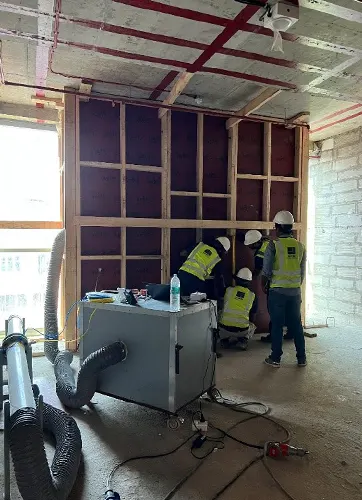
• For the mullion and the transom, the distance between the outermost transducers will be measured and recorded. The design load will be applied to the test chamber as per the standard requirements and procedure.
So, the question would be why do we test in a lab when we can do the air, water and structural test at the site and ensure that the workmanship was properly done? Due to site conditions, there is a limitation in performing all the testing at a site such as building movements testing [including live and dead load testing], dynamic water penetration testing, thermal cycling testing, etc. which gets covered in the lab test.
In a nutshell, by performing both tests, results can be compared and risk at the site can be reduced. Both lab tests and site tests are not interchangeable. They need to be considered independently.
What if the tests are not done?
If tests are not conducted on a façade system, it can potentially result in a number of issues or problems that could have been avoided if the proper testing had been performed. These problems could range from minor aesthetic issues to more serious safety concerns.
• In case of any excess air or water leakage, the hot air travels inside and damages the materials which in turn leads to interior damage which doubles the cost for contractors.
• Structural failure will have government as well as legal consequences.
• Seismic activities can lead to glass breakage and system failure.
The expense to perform these tests are lower compared to the cost that would be incurred in case of damage. So, to be on the safer side, it is advised to do the tests prior and guarantee the safety of the building. For every building, the project (building structure, interface, testing performed, etc.) in its entirety is different. The assessment of the capability of the contractor and the design applied to the new system is key.
